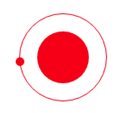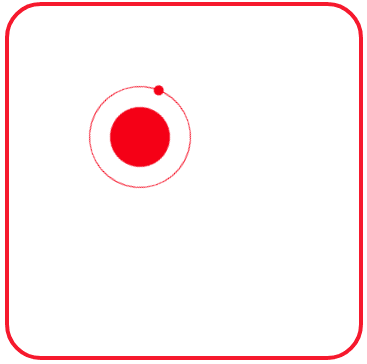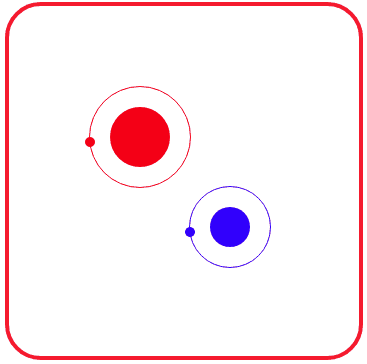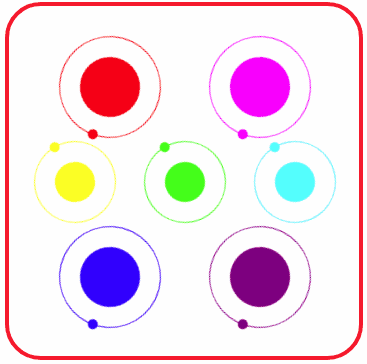CSS动画实例:行星和卫星
设页面中有<div class=" planet "></div>,用来绘制一个行星和卫星图形。这个图形包括三部分:行星、卫星和卫星旋转的轨道。定义. planet的样式规则如下:
.planet
{
position:absolute;
top:80px;
left:80px;
height:100px;
width:100px;
border-radius:50%; border:1px solid #f00;
animation:rond 3s linear infinite;
}
.planet:before
{
content: "";
height:10px;
width:10px;
position:absolute;
background-color:#f00;
border-radius:50%;
top:50px;
left:-5px;
}
.planet:after
{
content: '';
height:60px;
width:60px;
background:#f00;
border-radius:50%;
position:absolute;
top:20px;
left:20px;
}
可在页面中显示如图1所示的图案。

图1 行星和卫星
定义关键帧,使得卫星在轨道上绕行星旋转。编写的HTML文件如下。

<!DOCTYPE html> <html> <head> <title>行星和卫星</title> <style> .container { width:350px; height:350px; margin:100px auto; position:relative; border: 4px solid rgba(255, 0, 0, 0.9); border-radius: 10%; } .planet { position:absolute; top:80px; left:80px; height:100px; width:100px; border-radius:50%; border:1px solid #f00; animation:rond 3s linear infinite; } .planet:before { content: ""; height:10px; width:10px; position:absolute; background-color:#f00; border-radius:50%; top:50px; left:-5px; } .planet:after { content: ''; height:60px; width:60px; background:#f00; border-radius:50%; position:absolute; top:20px; left:20px; } @keyframes rond { 0% {transform : rotate(0deg);} 100% {transform : rotate(360deg);} } </style> </head> <body> <div class="container"> <div class="planet"></div> </div> </body> </html>
在浏览器中打开包含这段HTML代码的html文件,可以呈现出如图2所示的动画效果。

图2 绕行星旋转的卫星
在图2中有一颗红色的小卫星绕着红色的卫星旋转,再加入一个蓝色的小卫星绕着蓝色的行星旋转。可以编写如下的HTML文件。

<!DOCTYPE html> <html> <head> <title>行星和卫星</title> <style> .container { width:350px; height:350px; margin:100px auto; position:relative; border: 4px solid rgba(255, 0, 0, 0.9); border-radius: 10%; } .planet1 { position:absolute; top:80px; left:80px; height:100px; width:100px; border-radius:50%; border:1px solid #f00; animation:rond 3s linear infinite; } .planet1:before { content: ""; height:10px; width:10px; position:absolute; background-color:#f00; border-radius:50%; top:50px; left:-5px; } .planet1:after { content: ''; height:60px; width:60px; background:#f00; border-radius:50%; position:absolute; top:20px; left:20px; } .planet2 { position:absolute; top:180px; left:180px; height:80px; width:80px; border-radius:50%; border:1px solid #00f; animation:rond 3s linear infinite; } .planet2:before { content: ""; height:10px; width:10px; position:absolute; background-color:#00f; border-radius:50%; top:40px; left:-5px; } .planet2:after { content: ''; height:40px; width:40px; background:#00f; border-radius:50%; position:absolute; top:20px; left:20px; } @keyframes rond { 0% {transform : rotate(0deg);} 100% {transform : rotate(360deg);} } </style> </head> <body> <div class="container"> <div class="planet1"></div> <div class="planet2"></div> </div> </body> </html>
在浏览器中打开包含这段HTML代码的html文件,可以呈现出如图3所示的动画效果。

图3 绕各自轨道旋转的两颗卫星
上面的HTML文件中,为了绘制两颗行星,页面中定义了两个div:一个类名为planet1,另一个名为planet2。分别为两个类定义样式规则,这两个类的样式规则基本相同,复制后略作修改即可。
若在页面中搞多个绕各自轨道旋转的卫星怎么办呢?采用类似的方法(定义类名为planet3、planet4、…等层,再复制样式规则略作修改)虽然可以实现,但重复代码太多,导致HTML文件大小偏大。因此,采用自定义变量的方式更好些。
比较类.planet1和.planet2的样式规则定义,可以为一个绕轨道旋转的卫星抽象出5个属性:表示行星大小的--size、表示行星位置的--top和--left,表示卫星旋转速度的—speed、表示颜色的--color。
编写的HTML文件内容如下。

<!DOCTYPE html> <html> <head> <title>行星和卫星</title> <style> .container { width:350px; height:350px; margin:100px auto; position:relative; border: 4px solid rgba(255, 0, 0, 0.9); border-radius: 10%; } .planet { position:absolute; top:var(--top); left:var(--left); height:calc(var(--size) + 40px); width:calc(var(--size) + 40px); border-radius:50%; border:1px solid var(--color); animation:rond var(--speed) linear infinite; } .planet:before { content: ""; height:10px; width:10px; position:absolute; background-color:var(--color); border-radius:50%; top:calc(var(--size) / 2 + 20px); left:-5px; } .planet:after { content: ''; height:var(--size); width:var(--size); background:var(--color); border-radius:50%; position:absolute; top:20px; left:20px; } @keyframes rond { 0% {transform : rotate(0deg);} 100% {transform : rotate(360deg);} } </style> </head> <body> <div class="container"> <div class="planet" style="--size:60px;--left:50px; --top: 30px; --color:#f00; --speed: 3s;"></div> <div class="planet" style="--size:60px;--left:200px; --top: 30px; --color:#f0f; --speed: 3s;"></div> <div class="planet" style="--size:40px;--left:25px; --top: 135px; --color:#ff0; --speed: 2.5s;"></div> <div class="planet" style="--size:40px;--left:135px; --top: 135px; --color:#0f0; --speed: 2.5s;"></div> <div class="planet" style="--size:40px;--left:245px; --top: 135px; --color:#0ff; --speed: 2.5s;"></div> <div class="planet" style="--size:60px;--left:50px; --top: 220px; --color:#00f; --speed: 3s;"></div> <div class="planet" style="--size:60px;--left:200px; --top: 220px; --color:#800080; --speed: 3s;"></div> </div> </body> </html>
在浏览器中打开包含这段HTML代码的html文件,可以呈现出如图4所示的动画效果。

图4 绕各自轨道旋转的七颗卫星
通过这个例子,可以体会CSS中自定义变量的使用方法。






【推荐】国内首个AI IDE,深度理解中文开发场景,立即下载体验Trae
【推荐】编程新体验,更懂你的AI,立即体验豆包MarsCode编程助手
【推荐】抖音旗下AI助手豆包,你的智能百科全书,全免费不限次数
【推荐】轻量又高性能的 SSH 工具 IShell:AI 加持,快人一步
· 基于Microsoft.Extensions.AI核心库实现RAG应用
· Linux系列:如何用heaptrack跟踪.NET程序的非托管内存泄露
· 开发者必知的日志记录最佳实践
· SQL Server 2025 AI相关能力初探
· Linux系列:如何用 C#调用 C方法造成内存泄露
· 震惊!C++程序真的从main开始吗?99%的程序员都答错了
· 别再用vector<bool>了!Google高级工程师:这可能是STL最大的设计失误
· 【硬核科普】Trae如何「偷看」你的代码?零基础破解AI编程运行原理
· 单元测试从入门到精通
· 上周热点回顾(3.3-3.9)